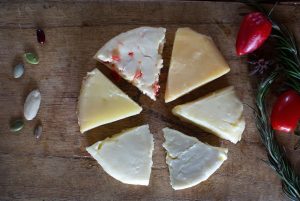Categories of Aging
At PT. Pasti Enak, we define Cheese Aging, or Affinage, as the stage where cheese transforms into something extraordinary. Although every cheese spends at least a few days maturing, we mark the beginning of “aged” cheeses at four weeks.
To guide customers and staff, we classify cheeses into clear categories:
- Non‑Aged – less than 1 month
- Short‑Aged – 1 to 2 months
- Medium‑Aged – 2 to 9 months
- Long‑Aged – more than 12 months
This system allows us to communicate flavor expectations and texture development clearly to both retail and wholesale clients.
The Science of Cheese Aging / Affinage
Cheesemakers start by reducing water and soluble elements in milk to form a semi‑solid mass. This mass, packed with proteins, fats, sugars, and minerals, creates the perfect environment for beneficial bacteria, yeasts, and molds — a group of microorganisms known as microflora.
As the microflora grow, they actively transform the cheese’s flavor, aroma, and appearance.
Nurturing microflora stands at the heart of Affinage. Cheesemakers regulate temperature, humidity, and airflow to guide the growth of specific microorganisms. With this careful management, they shape each cheese’s unique character — from the creamy bloom of Brie to the sharp bite of cave‑aged Cheddar.

Tradition and the Role of Affineurs
Historically, farmers cared for animals, milked them, and produced wheels of cheese. However, because they lacked time to manage aging, specialists known as Affineurs stepped in to care for cheeses as they matured. Their artistry, called Affinage, became highly prized.
Affineurs brush, wash, and turn cheeses hundreds of times during maturation. Consequently, these actions influence rind formation, texture, and flavor. Therefore, gourmands and professional cheesemakers often classify cheeses by the affinage techniques used.
Cheese Aging / Affinage as an Art Form
Affinage is more than science; it is art. Affineurs act with intuition, adjusting techniques for each batch to bring out the best qualities. The process resembles painting: they treat the cheese as the canvas and use microbiology and chemistry as their brushes.
Cheese passes through many stages as it develops toward peak flavor. When that moment arrives, the Affineur determines that the cheese is ready for sale. This choice demands skill, precise timing, and deep knowledge of the product.
Living Foods and Care
Natural cheeses live and breathe. They demand constant attention, and careless handling quickly creates defects. Affineurs use proper Cheese Aging, or Affinage, to ensure that each cheese matures into a product with remarkable character.
It is extraordinary how simple ingredients — milk, cultures, and salt — can produce cheeses with endless shapes, colors, textures, and aromas. This variety shows why affinage blends science with art, and why PT. Pasti Enak places it at the heart of our philosophy.

Cheese by Aging Length
Non‑Aged Cheeses in this category are ready to eat within just a few days. Alternatively, they may be aged for up to one month, which gives them a fresh and delicate flavor.
Short‑Aged
We consider short‑aged cheeses to be those matured for 1–2 months before being ready for sale. As a result, they often develop more body and complexity compared to non‑aged varieties.
Medium‑Aged
Pasti Enak classifies medium‑aged cheeses as those aged for 2–9 months. During this time, flavors deepen and textures become firmer, making them versatile for both cooking and cheese platters.
Long‑Aged
We consider any cheese aged for a minimum of 9 months to be long‑aged. In fact, some cheeses, such as Parmesan or Caprino Romano, are matured for 1–2 years. Because of this extended aging, they develop their characteristic sharp flavors and crumbly textures.
Affinage Technique
Fresh Cheeses
Although we consider some of our cheeses to be without Affinage, in reality all cheeses require at least a little care to maintain their quality. For this reason, fresh cheeses must be properly packed and stored under the right environmental conditions. As a result, they retain their delicate flavor and texture until they reach the customer.
Washed Rind
As the name suggests, washed rind cheeses are regularly washed during aging. Through this process, we apply a variety of washes with carefully selected microbial compositions. As a result, each cheese develops distinctive flavors, complex aromas, and unique rind appearances. Because of this careful handling, washed rind cheeses often stand out as some of the most characterful and memorable varieties in our collection.
Mold Ripened
A variety of molds are utilized in cheesemaking, each contributing to unique flavors and appearances. Most notably, Camemberti mold produces the characteristic fluffy white rind found on Camembert and similar soft cheeses. In addition, Penicillium roqueforti is widely used in the production of blue cheeses. Because of its activity, these cheeses develop their distinctive veins, sharp flavors, and complex aromas. Together, such molds highlight the essential role of microbiology in shaping the diversity of cheese styles.
